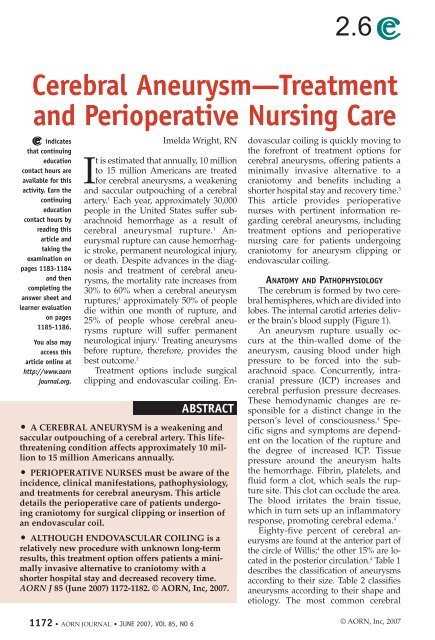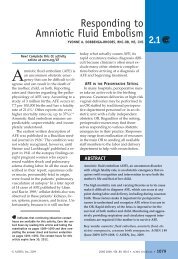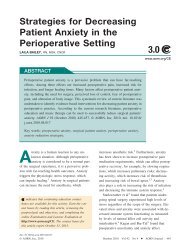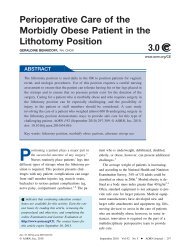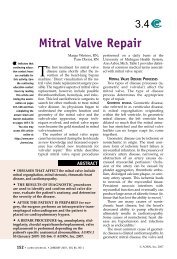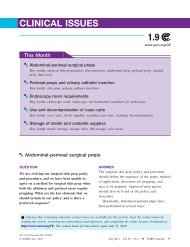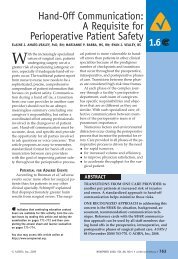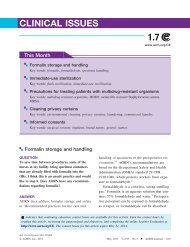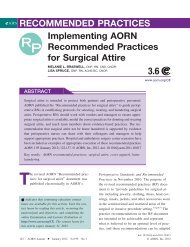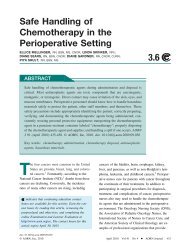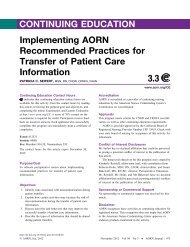Cerebral Aneurysm—Treatment and Perioperative Nursing ... - AORN
Cerebral Aneurysm—Treatment and Perioperative Nursing ... - AORN
Cerebral Aneurysm—Treatment and Perioperative Nursing ... - AORN
You also want an ePaper? Increase the reach of your titles
YUMPU automatically turns print PDFs into web optimized ePapers that Google loves.
Sorted By AuthorBurch, R. Queenie Peavy 159 teen's fiction rspt 5.6 5.0Burch, R. Renfroe’s Christmas children's fiction rsptBurton, V. Katy <strong>and</strong> the Big Snow 36 children's storybook rspn 2.9 5.0Mike Mulligan <strong>and</strong> HisSteam Shovel 48 children's storybook trst 4.4 0.5Burton, V.Byars, B. 18th Emergency 126 children's fiction rspt 4.7 4.0Byars, B. After the Goat Man 126 children's fiction trst 4.5 3.0Byars, B. Glory Girl 121 children's fiction rspt 4.2 3.0Byars, B. Night Swimmers 131 teen's fiction rspn 4.3 3.0Byars, B. Pinballs 136 children's fiction rspt 3.8 3.0Byars, B. Summer of the Swans 142 teen's fiction rspn 4.9 4.0Caines, J. Daddy children's storybook rsptCarle, E. Grouchy Ladybug 41 children's storybook rspt 2.8 0.5Carlson, N. Brother for the Orphelines 100 children's fiction rspnCarlson, N. Family under the Bridge 99 children's fiction rspn 4.7 3.0Carrick, C. Climb children's storybook trstCarrick, C. Some Friend! 112 children's fiction trstCarrick, C. What a Wimp! 89 children's fiction rspnCaudill, R. Pocketful of Cricket children's storybook rspt 3.5 0.5Chambers, A. Present Takers 156 children's fiction citzCharlip, R.Harlequin <strong>and</strong> the Gift ofMany Colors children's storybook careChorao, K. Molly’s Lies 32 children's storybook trstChristopher, M. Fox Steals Home 178 children's fiction fair 4.5 4.0My Dad Is ReallyChurch Mice Adrift. Unp. Something children's storybook rsptCleary, B. Henry <strong>and</strong> the Clubhouse 192 children's fiction rspn 5.1 4.0Cleary, B. Henry <strong>and</strong> the Paper route 192 children's fiction rspn 5.3 4.0Cleary, B. Henry Huggins children's fiction rspn 4.7 3.0Cleary, B. Ramona the Brave 190 children's fiction rspt 4.9 3.0Clifton, L. Everett Anderson’s Friend children's storybook fair 2.9 0.5Clifton, L. My Friend Jacob children's storybook rsptClymer, E. Get-away Car 149 children's fiction rspnClymer, E. Horse in the Attic 87 children's fiction rspnClymer, E. My Brother Stevie 76 children's fiction rspn 4.1 7.0Coatsworth, E. Marra’s World 83 children's fiction rsptCohen, B. Molly’s Pilgrim 32 children's fiction care 3.0 0.5Cohen, B.Thank You, JackieRobinson 125 teen's fiction fair 4.4 4.0Cohen, M. Best Friends 32 children's storybook rspt 3.4 0.5See You Tomorrow,Cohen, M.Charles children's storybook care 2.3 0.5Cohen, M. So What? 32 children's storybook rspt 2.5 0.5Collier, J. My Brother Sam Is Dead 224 teen's fiction trst 4.9 7.0Conford, E. Felicia the Critic 145 children's fiction rspt 4.8 4.0Abuelita Full of Life-llenade vida 30 children's storybook care 3.7 0.5Costalese, ACoutant, H. Gift children's fiction careCrofford, E. Stories from the Blue Road children's fiction rsptCreated by: Tulare County, PCEP CHARACTER COUNTS! Grant Curriculum Specialist
JUNE 2007, VOL 85, NO 6Wrightbe performed; so ideally, the surgical procedureis performed in a room that hasangiographic capability. No matter whichprocedure will be performed, one backtable is prepared for cerebral angiography.The angiography back table includes• an angiography pack,• a gown <strong>and</strong> gloves for the neurosurgeon,• a syringe <strong>and</strong> needle for administeringlocal anesthesia,• a percutaneous entry needle,• an arterial pressure monitoring kit,• a customized kit for delivering heparinizedsaline,• extension tubing,• a femoral-artery introducing sheath,• a selection of arterial sealing devices,• angiographic guide wires <strong>and</strong> catheters,<strong>and</strong>• contrast dye <strong>and</strong> heparinized salinein labeled containers.CRANIOTOMY FOR ANEURYSM CLIPPING SETUP. Asecond back table is prepared for a craniotomy.The table includes• a craniotomy instrument set;• a craniotomy pack;• a drill with accessories;• a selection of suction tips;• aneurysm clips <strong>and</strong> clip appliers(Figures 3 <strong>and</strong> 4);• a micro-Doppler probe;• monopolar <strong>and</strong> bipolar electrosurgeryunit (ESU) supplies;• physician-preferred retractors <strong>and</strong>dissectors; <strong>and</strong>• various sizes of cottonoids <strong>and</strong> hemostaticagents (eg, wax, hemoclips,hemostatic sponges).The circulating nurse ensures thatdura repair supplies <strong>and</strong> materials arereadily available but not opened untilthey are needed. The circulating nurseaseptically delivers medications intocontainers that the scrub person has labeledon the back table, including• the physician’s preferred local anesthesia,• antibiotic irrigation, <strong>and</strong>• thrombin mixed with gelfoam.The circulating nurse ensures that thefollowing equipment is in the room <strong>and</strong>functioning properly before the patientis brought into the room:• a radiolucent OR bed designed forboth angiographic <strong>and</strong> craniotomyprocedures;• a radiolucent, neurosurgical, threepointheadrest <strong>and</strong> table attachment;• a microscope;• monopolar <strong>and</strong> bipolar ESUs; <strong>and</strong>• a foot pedal for the drill.ENDOVASCULAR COILING SETUP. The risk ofaneurysm rupture during an endovascularcoiling procedure is low; however, thecirculating nurse <strong>and</strong> scrub personshould have supplies for a ventriculostomyreadily available should a ruptureoccur. In addition to a cerebral angiographypack, the circulating nurse <strong>and</strong> scrubperson open• gowns <strong>and</strong> gloves,• a femoral artery introducing sheath,• a percutaneous entry needle, <strong>and</strong>• an arterial pressure monitoring kit.They also ensure that a full supply ofendovascular wires, catheters, coils,<strong>and</strong> stents are available. The circulatingnurse aseptically delivers medicationsinto containers that the scrub personhas labeled on the angiographyback table, including• local anesthesia as requested by thesurgeon,• contrast dye, <strong>and</strong>• heparinized saline for irrigation.The circulating nurse prepares additionalheparinized saline for patientsystemic heparinization during theprocedure. The circulating nurse deliversthis additional heparinizedsaline to the surgical field via tubingthat is attached to sterile extensiontubing <strong>and</strong> a delivery kit on the surgicalfield. The surgeon will administerthis systemic heparinized solution viathe femoral artery.1176 • <strong>AORN</strong> JOURNAL
Wright JUNE 2007, VOL 85, NO 6Figure 3 • <strong>Cerebral</strong> aneurysmclips come in a variety ofshapes <strong>and</strong> sizes.PREOPERATIVENURSING CAREAfter the patient completesthe admission process,an admission clerkescorts or directs him orher to the preoperativearea. The preoperativenurse greets the patient<strong>and</strong> instructs him or her tochange into a hospitalgown. After taking the patient’svital signs, the preoperativenurse obtainsthe patient’s health history<strong>and</strong> verifies his or herNPO status <strong>and</strong> allergies.After ensuring that appropriatelaboratory resultsare in the patient’s medicalrecord, the nurse performsa baseline neurological assessment<strong>and</strong> documentsany deficits. The nurse notifiesthe anesthesia careprovider <strong>and</strong> the surgeonabout any abnormalities.The preoperative nurseputs thromboembolic disease(TED) stockings <strong>and</strong>intermittent pneumaticcompression (IPC) cuffson the patient.The surgeon arrives in the preoperativearea <strong>and</strong> obtains informed consentfor cerebral angiography <strong>and</strong> craniotomyfor aneurysm clipping or endovascularcoiling, depending on the procedure to beperformed. The anesthesia care providerarrives <strong>and</strong> obtains the patient’s informedconsent for anesthesia, including placementof central lines. The preoperativenurse then assists the surgeon or anesthesiacare provider during insertion of anarterial line, which allows for accurate intraoperativeblood pressure monitoring.The diagnosis of cerebral aneurysm<strong>and</strong> the prospect of undergoing a craniotomyare very frightening for patients;therefore, it is important for all perioperativenurses to monitor the emotionalstate of the patient <strong>and</strong> his or her familymembers. The perioperative nursesoffer reassurance <strong>and</strong> support, givingthe patient <strong>and</strong> family members an opportunityto express fears <strong>and</strong> concerns.The preoperative nurse assesses the patient’sunderst<strong>and</strong>ing of the procedure<strong>and</strong> tells the patient what to expect inthe immediate postoperative period.The circulating nurse goes to the preoperativearea to interview the patient<strong>and</strong> review the patient’s medical record.The circulating nurse ensures that theconsent forms are signed <strong>and</strong> dated byFigure 4 •The clipapplier holdsthe clip inplace untilthe surgeonis ready todeploy itacross theneck of theaneurysm.<strong>AORN</strong> JOURNAL • 1177
JUNE 2007, VOL 85, NO 6WrightGood bodyalignment is vital.If the patient’shead is turned farto one side forsurgical access,the circulatingnurse places asupportive padunder theaffected shoulderto preventneck strain.the patient <strong>and</strong> surgeon or anesthesiacare provider <strong>and</strong> that the preoperativenurse who witnessed the patient’s signaturehas signed the forms. The circulatingnurse ensures that all laboratoryresults are available <strong>and</strong> that the surgeon<strong>and</strong> anesthesia care provider havebeen notified of any abnormal laboratorytest results. The circulating nursegreets the patient <strong>and</strong> performs a preoperativeassessment, after which he or shedevelops a care plan specificto this patient (Table3). When the patient <strong>and</strong>chart are ready, the circulatingnurse transports thepatient to the OR suite.INTRAOPERATIVENURSING CAREAfter assisting the patientonto the OR bed, thecirculating nurse placesthe safety strap across thepatient’s thighs, <strong>and</strong> securesthe patients arms tothe padded arm boards.After placing paddingunder the patient’s heels,the circulating nurse assiststhe anesthesia careprovider with applyingmonitoring devices <strong>and</strong>ensures that the electrocardiographleads areplaced in a position thatwill not interfere with fluoroscopicimage clarity. Thecirculating nurse then appliesan upper-body, temperature-regulatingblanketon the patient <strong>and</strong> warm blankets onthe patient’s lower body. The circulatingnurse checks <strong>and</strong> documents the patient’sbilateral dorsalis pedis <strong>and</strong> posterior tibialpulses for a baseline measurement.The nurse then connects the IPC tubing tothe IPC cuffs <strong>and</strong> activates the IPC device.The circulating nurse <strong>and</strong> scrub personthen perform a count of sponges, sharps,<strong>and</strong> instruments. The circulating nurseensures that the count is documentedproperly. When all members of the intraoperativeteam are present, the circulatingnurse initiates a surgical time out. AllOR personnel ensure that noise <strong>and</strong> theactivity level in the room are kept to aminimum, particularly during inductionof anesthesia. The circulating nurse assiststhe anesthesia care provider duringinduction <strong>and</strong> endotracheal intubation.The circulating nurse inserts an indwellingurinary catheter. He or sheplaces a monopolar, ESU dispersive padon one of the patient’s thighs for aneurysmclipping procedures. The circulatingnurse pads the patient’s arms <strong>and</strong>tucks them at the patient’s sides. Thenurse evaluates the patient’s position, ensuringthat all bony prominences <strong>and</strong>pressure points are adequately padded.The nurse uses a clippers to remove hairfrom the patient’s bilateral groin areas<strong>and</strong> performs a surgical prep of the areain anticipation of the preprocedure cerebralangiogram (Figure 5).The circulating nurse <strong>and</strong> anesthesiacare provider document proceduralevents <strong>and</strong> implantation of coils, if pertinent,<strong>and</strong> monitor blood loss. The circulatingnurse provides updates by telephoneto the family during the surgery.CRANIOTOMY WITH ANEURYSM CLIPPINGThe neurosurgeon, circulating nurse,<strong>and</strong> anesthesia care provider place thepatient’s head in the neurosurgical,three-point headrest using sterile technique<strong>and</strong> sterile head pins. The circulatingnurse applies antibiotic ointmentaround the puncture sites. Good bodyalignment is vital, <strong>and</strong> it is particularlyimportant that the patient’s neck iscarefully positioned. If the patient’shead is turned far to one side for accessto the aneurysm, it may be necessary toplace a supportive pad under the affectedshoulder to prevent neck strain. 101178 • <strong>AORN</strong> JOURNAL
Wright JUNE 2007, VOL 85, NO 6TABLE 3<strong>Nursing</strong> Care Plan for a Patient UndergoingSurgery for Treatment of <strong>Cerebral</strong> AneurysmDiagnosisRisk fordecreasedcardiac outputrelated tocardiovascularfunction,anesthesia,<strong>and</strong> surgicalintervention.<strong>Nursing</strong> interventions• Identifies baseline cardiac <strong>and</strong> vascular status<strong>and</strong> reviews diagnostic evaluations (eg,electrocardiogram [ECG], laboratory testresults).• Uses monitoring equipment to assess cardiac<strong>and</strong> vascular status (eg, ECG, arterialline, pulmonary artery catheter, Doppler).• Assesses peripheral pulses, skin pallor,numbness, <strong>and</strong> tingling of extremities.• Observes for signs <strong>and</strong> symptoms of hypovolemiain postoperative period related toblood loss.• Evaluates postoperative vascular function.Interim outcomecriteriaPatient’scardiovascularfunction ismaintained orimproved frombaseline levels,ensuringadequate bloodflow to thepatient’sextremities.OutcomestatementPatient isfree of signs<strong>and</strong> symptomsofdistalembolism<strong>and</strong> hypovolemia.Risk forinfectionrelated to thesurgicalprocedure.• Assesses skin integrity, sensory impairments,<strong>and</strong> susceptibility for infection.• Validates that preoperative antibiotic wasadministered according to facility policy.• Allows sufficient time for surgical prepsolution to dry before the patient is draped.• Minimizes length of invasive procedure byplanning care <strong>and</strong> obtaining necessaryequipment expeditiously.• Monitors sterile field <strong>and</strong> perioperativeteam members to ensure that asepsis ismaintained.• Initiates <strong>and</strong> maintains traffic control.• Classifies surgical wound (eg, class I).• Dresses wound at completion of procedure.Patientdemonstrates dry,nonreddened,nontender woundhealing byprimary intention.Patient isfree ofsigns <strong>and</strong>symptoms ofhealth careassociatedinfection for30 daysafter theperioperativeprocedure.Risk of anxietyrelated toknowledgedeficit <strong>and</strong>stress ofsurgery.Risk forinjury relatedto positioning.• Identifies communication barriers <strong>and</strong>knowledge level (eg, expected outcomes,surgical risks <strong>and</strong> complications).• Assesses readiness to learn <strong>and</strong> copingmechanisms.• Explains sequence of events <strong>and</strong> reinforcesteaching about cerebral aneurysms, surgicaltreatment options, <strong>and</strong> recovery.• Provides instruction (ie, oral, written) forsurgical procedure <strong>and</strong> discharge, includingsigns <strong>and</strong> symptoms of postoperativehemorrhage.• Evaluates response to instruction.• Identifies physical alterations that may affectprocedure-specific positioning.• Places the patient in an anatomically correctposition <strong>and</strong> implements protectivemeasures to prevent tissue injury.• Uses supplies <strong>and</strong> equipment within safeparameters.• Evaluates for signs <strong>and</strong> symptoms of skin<strong>and</strong> tissue injury.Patient verbalizesunderst<strong>and</strong>ing ofthe procedure,sequence ofevents, expectedoutcomes, <strong>and</strong>concerns abouttreatmentdecisions beingdiscussed <strong>and</strong>participates indecision making.Patient’s skinremains intact,nonreddened, <strong>and</strong>free from ecchymosis<strong>and</strong> thepatient maintainscirculation, sensation,<strong>and</strong> functionrelated to surgicalpositioning.Patientdemonstratesknowledgeof thephysiological<strong>and</strong>psychologicalresponsesto theprocedure.Patient isfree fromsigns <strong>and</strong>symptoms ofinjuryrelated topositioning.<strong>AORN</strong> JOURNAL • 1179
JUNE 2007, VOL 85, NO 6WrightFigure 5 • A cerebral angiogramis performed preoperatively <strong>and</strong>postoperatively. Ideally, the procedureis performed in a suitedesigned for neuroradiography.The neurosurgeon clips the hairfrom the surgical area of the patient’shead, <strong>and</strong> the circulating nurse performsthe surgical skin prep. While thisis occurring, the scrub person drapesthe microscope. After the scrub person<strong>and</strong> surgeon drape the surgical area,the circulating nurse positions <strong>and</strong> connectsthe unipolar <strong>and</strong> bipolar ESUs,foot pedals (eg, bipolar ESU, powerdrill), <strong>and</strong> suction devices.The location of the surgical incisiondepends on the location of the cerebralaneurysm. After making the initial incision,the neurosurgeon applies scalpclips to the skin edges. He or she performssoft tissue separation from underlyingbone with an elevator <strong>and</strong> then attachesdura hooks to a separate Mayost<strong>and</strong> to secure the scalp flap. Afterdrilling burr holes into the cranium at thefour corners of the incision site, the neurosurgeonsaws between the burr holes<strong>and</strong> separates the bone flap from the underlyingdura with elevators <strong>and</strong> dissectorsin order to turn the bone flap.The circulating nurse moves the microscopeinto position, <strong>and</strong> the neurosurgeonuses it to locate <strong>and</strong> carefully isolatethe aneurysm <strong>and</strong> the blood vessels thatfeed it. Delicate movements are used toprevent disruption of surrounding braintissue. The neurosurgeon carefully separatesthe aneurysm from the surroundingtissue <strong>and</strong> then places one or more smallaneurysm clips across the neck of theaneurysm (Figure 6). The neurosurgeonthen closes the dura <strong>and</strong>replaces the bone flap withscrews <strong>and</strong> plates. 10 He orshe then closes the scalp.The circulating nurse assiststhe neurosurgeonwith removing the neurosurgical,three-point headrestfrom the patient’shead <strong>and</strong> applying a cranialwound dressing.When the craniotomyis complete, the neurosurgeon performsa repeat cerebral angiogram to examinethe cerebral blood flow. The surgeonseals the femoral artery with an arterysealing device <strong>and</strong> applies pressure forseveral minutes before applying afemoral wound dressing.ENDOVASCULAR COILING PROCEDUREThe endovascular coiling procedureis performed by an interventional neurosurgeonor neuroradiologist. Theneurosurgeon or neuroradiologist insertsan endovascular catheter into thepatient’s femoral artery <strong>and</strong> performsa preprocedure cerebral angiogram tolocate the aneurysm. The surgeon orradiologist delivers heparinized salinesystemically via the femoral arteryduring the procedure. Aided by fluoroscopy,the surgeon or radiologistthreads the catheter to the aneurysmalsite. When the correct position is obtained,he or she introduces a detachablecoil into the lumen <strong>and</strong> uses anelectrical impulse to detach the coilfrom the catheter (Figure 7).One or more coils may be needed tofill the aneurysm sac. If the neck of theaneurysm is too wide to hold the coils,the surgeon or radiologist may place astent across the neck of the aneurysm.The stent allows for safe deposition ofthe coils without allowing a coil mass toprotrude into the main artery. The surgeonor radiologist removes the catheterwhen the coils have been successfully1180 • <strong>AORN</strong> JOURNAL
Wright JUNE 2007, VOL 85, NO 6Figure 6 • Two titanium clipsare applied to the neck ofthe aneurysm.deployed. He or she placesan arterial sealing devicein the femoral arterypuncture site after theprocedure is complete <strong>and</strong>applies pressure to thearea for several minutesbefore applying a femoralwound dressing.POSTOPERATIVE NURSING CAREAs the patient is waking from anesthesiain the OR, the anesthesia careprovider reminds the patient not to movethe leg in which the angiogram was performed.The surgical team then carefullytransfers the patient to a hospital bed.The circulating nurse secures a sheetover the patient’s surgical leg <strong>and</strong> tucks itunder the mattress on both sides of thebed to help prevent unnecessary legmovement. The anesthesia care provider<strong>and</strong> circulating nurse transport the patientto the postanesthesia care unit(PACU), where both provide a detailedh<strong>and</strong>-off report to the receiving PACUnurse. The circulating nurse ensures thatthe PACU nurse is aware of any neurologicaldeficits that the patient may havepresented with preoperatively.The PACU nurse documents the patient’sarrival vital signs <strong>and</strong> performs aneurological assessment. The nursechecks the cranial <strong>and</strong> femoral dressingsfor bleeding <strong>and</strong> checks the patient’spedal pulses for evidence of occlusion.The patient remains on bed restwith the affected leg extended for a periodof time determined by the surgeon.The PACU nurse remains vigilant <strong>and</strong>immediately reports any signs <strong>and</strong>symptoms of a retroperitoneal bleeding(eg, low systolic blood pressure, abdominalpain or discomfort) or evidenceof hemorrhage or vasospasm (eg,neurological deterioration).Typically, a patient who has undergonecraniotomy for aneurysm clippingspends two nights in an intensivecare unit (ICU) <strong>and</strong> an additional threenights in a medical-surgical unit beforebeing discharged home. In contrast,a patient who has undergone anendovascular coiling procedure typicallyspends one night in ICU <strong>and</strong> oneadditional night in a medical-surgicalunit. Either treatment course may requirerehabilitation before the patientis discharged home, depending onhow the patient recovers or if he or sheexperiences complications.abcFigure 7 • Tinyplatinum coilsare fed througha catheter (a)<strong>and</strong> deployedinto theaneurysm (b).The coils <strong>and</strong>subsequentblood clotfill theaneurysm (c).<strong>AORN</strong> JOURNAL • 1181
1. Despite advances in the diagnosis<strong>and</strong> treatment of cerebral aneurysms,when a cerebral aneurysmruptures, the mortality rate increasesfrom 30% to _______.a. 60%b. 70%c. 80%Examination<strong>Cerebral</strong> <strong>Aneurysm—Treatment</strong> <strong>and</strong><strong>Perioperative</strong> <strong>Nursing</strong> CarePURPOSE/GOALTo educate perioperative nurses about caring for patients undergoing treatmentfor cerebral aneurysms.BEHAVIORAL OBJECTIVESAfter reading <strong>and</strong> studying the article on cerebral aneurysms, nurses will be able to1. describe the effects of aneurysmal rupture,2. identify common clinical methods used to diagnose the presence of a cerebralaneurysm,3. discuss causes of cerebral aneurysms,4. compare craniotomy for surgical aneurysm clipping to insertion of an endovascularcoil as treatment options for a cerebral aneurysm, <strong>and</strong>5. discuss nursing care of a patient undergoing treatment for cerebral aneurysm.QUESTIONS2. When an aneurysm rupture occurs,1. blood is forced under highpressure into the subarachnoidspace.2. intracranial pressure decreases<strong>and</strong> cerebral perfusion pressureincreases.3. tissue pressure around theaneurysm halts the hemorrhage.4. fibrin, platelets, <strong>and</strong> fluid form aclot, which seals the rupture sitebut can occlude the area.5. the blood irritates the braintissue, which consequently promotescerebral edema.a. 1 <strong>and</strong> 3b. 2 <strong>and</strong> 4c. 1, 3, 4, <strong>and</strong> 5d. 1, 2, 3, 4, <strong>and</strong> 53. Diagnosis of cerebral aneurysms isbased on1. the patient’s history <strong>and</strong> neurologicalassessment.2. a computed tomography scan.3. magnetic resonance imaging.4. cerebral angiography.a. 1 <strong>and</strong> 2b. 3 <strong>and</strong> 4c. 2, 3, <strong>and</strong> 4d. 1, 2, 3, <strong>and</strong> 44. Although theories abound regardingthe etiology of most aneurysms, mycoticaneurysms are caused bya. bacterial <strong>and</strong> fungal infections.b. excessively high blood pressure.2.6<strong>AORN</strong> isaccredited asa provider ofcontinuingnursingeducation bythe AmericanNursesCredentialingCenter’sCommission onAccreditation.<strong>AORN</strong> isproviderapprovedbythe CaliforniaBoard ofRegistered<strong>Nursing</strong>,ProviderNumber CEP13019. Checkwith yourstate board ofnursing foracceptance ofthis activityfor relicensure.This programmeets criteriafor CNOR<strong>and</strong> CRNFArecertification,as well asothercontinuingeducationrequirements.© <strong>AORN</strong>, Inc, 2007JUNE 2007, VOL 85, NO 6 • <strong>AORN</strong> JOURNAL • 1183
JUNE 2007, VOL 85, NO 6Examinationc. genetic factors.d. trauma.5. Aneurysms that have been completelyclipped often reoccur.a. trueb. false6. Performing an aneurysm clippingprocedure1. minimizes the necessity forperiodic follow-up angiographicstudies.2. provides controlled access to difficultanatomy.3. allows for arterial reconstructionwhen aneurysms have complicatedshapes <strong>and</strong> wide necks.a. 1b. 3c. 2 <strong>and</strong> 3d. 1, 2, <strong>and</strong> 37. The risk of bleeding or rebleedingis greatly reduced or eliminatedwhen an endovascular coil is usedbecause thea. aneurysm sac is completely removedduring the procedure.b. packed coils <strong>and</strong> subsequentthrombus formation prevent bloodfrom entering the aneurysm.c. white blood cells surround <strong>and</strong>destroy the aneurysm sac.d. the endovascular coil is securedtightly around the neck of theaneurysm.8. Which of the following nursing interventionswould be most applicablefor the nursing diagnosis “Riskfor decreased cardiac output relatedto cardiovascular function, anesthesia,<strong>and</strong> surgical intervention?”1. Assesses peripheral pulses, skinpallor, numbness, <strong>and</strong> tingling ofextremities.2. Assesses skin integrity, sensoryimpairments, <strong>and</strong> susceptibilityfor infection.3. Evaluates for signs <strong>and</strong> symptomsof skin <strong>and</strong> tissue injury.4. Evaluates postoperative vascularfunction.5. Observes for signs <strong>and</strong> symptomsof hypovolemia in postoperativeperiod related to bloodloss.a. 1 <strong>and</strong> 3b. 2 <strong>and</strong> 4c. 1, 4, <strong>and</strong> 5d. 1, 2, 3, 4, <strong>and</strong> 59. If the neck of the aneurysm is toowide to hold the coils during an endovascularcoiling procedure, thesurgeon or radiologist maya. apply an aneurysm clip across theneck of the aneurysm.b. use bipolar electrocautery to cauterizethe aneurysm sac.c. place a stent across the neck of theaneurysm.d. opt to use the surgical clipping procedure.10. The postanesthesia care unit nursewatches for signs <strong>and</strong> symptoms of aretroperitoneal bleeding, which mayinclude1. abdominal pain or discomfort.2. excessive agitation.3. loss of peripheral pulses.4. low systolic blood pressure.a. 1 <strong>and</strong> 4b. 2 <strong>and</strong> 3c. 1, 3, <strong>and</strong> 4d. 1, 2, 3, <strong>and</strong> 4The behavioral objectives <strong>and</strong> examination for this program were prepared by RebeccaHolm, RN, MSN, CNOR, clinical editor, with consultation from Susan Bakewell, RN,MS, BC, director, Center for <strong>Perioperative</strong> Education.1184 • <strong>AORN</strong> JOURNAL
Answer Sheet<strong>Cerebral</strong> <strong>Aneurysm—Treatment</strong> <strong>and</strong><strong>Perioperative</strong> <strong>Nursing</strong> Care 2.6Please fill out the application<strong>and</strong> answer form on this page<strong>and</strong> the evaluation form onthe back of this page. Tear thepage out of the Journal ormake photocopies <strong>and</strong> mail with appropriatefee to:<strong>AORN</strong> Customer Servicec/o <strong>AORN</strong> Journal Continuing Education2170 S Parker Rd, Suite 300Denver, CO 80231-5711or fax with credit card information to(303) 750-3212.Additionally, please verify by signature that youhave reviewed the objectives <strong>and</strong> read thearticle, or you will not receive credit.Signature ________________________1. Record your <strong>AORN</strong> member identificationnumber in the appropriate sectionbelow. (See your member card.)2. Completely darken the spaces that indicateyour answers to examinationquestions one through 10. Use blue orblack ink only.3. Our accrediting body requires that weverify the time you needed to completethis 2.6 continuing education contact hour(156-minute) program.________minutes4. Enclose fee if information is mailed.<strong>AORN</strong> (ID) # _______________________________Name _____________________________________Address ___________________________________City_______________________________________ State __________ Zip ____________Phone number______________________________RN license #________________________________ State __________________________Fee enclosed _______________________________or bill the credit card indicated ■ MC ■ Visa ■ American Express ■ DiscoverCard # ____________________________________Expiration dateSignature _________________________________________________ (for credit card authorization)Event#07033Session#8456Continuingeducationcontact hours:2.6Fee:Members$13.00Nonmembers$26.00ProgramofferedJune 2007The deadlinefor thisprogram isJune 30,2010A score of 70%correct on theexaminationis requiredfor credit.Participantsreceivefeedback onincorrectanswers.Each applicantwho successfullycompletesthis programwill receive acertificate ofcompletion.© <strong>AORN</strong>, Inc, 2007 JUNE 2007, VOL 85, NO 6 • <strong>AORN</strong> JOURNAL • 1185
Learner Evaluation<strong>Cerebral</strong> <strong>Aneurysm—Treatment</strong> <strong>and</strong><strong>Perioperative</strong> <strong>Nursing</strong> Care 2.6ObjectivesTo what extent were the following objectivesof this continuing educationprogram achieved?1. Describe the effects of aneurysmalrupture.2. Identify common clinical methodsused to diagnose the presence of acerebral aneurysm.3. Discuss causes of cerebral aneurysms.4. Compare craniotomy for surgical aneurysmclipping to insertion of anendovascular coil as treatment optionsfor a cerebral aneurysm.5. Discuss nursing care of a patient undergoingtreatment for cerebral aneurysm.ContentTo what extent6. did this article increase your knowledgeof the subject matter?7. was the content clear <strong>and</strong> organized?8. did this article facilitate learning?9. were your individual objectives met?10. did the objectives relate to the overallpurpose/goal?Test Questions/AnswersTo what extent11. were they reflective of the content?12. were they easy to underst<strong>and</strong>?13. did they address important points?Learner Input14. Will you be able to use the informationfrom this article in yourwork setting?a. yes b. no15. I learned of this article viaa. the Journal I receive as an <strong>AORN</strong>member.b. a Journal I obtained elsewhere.c. the <strong>AORN</strong> Journal web site.16. What factor most affects whetheryou take an <strong>AORN</strong> Journal continuingeducation examination?a. need for continuing educationcontact hoursb. pricec. subject matter relevant to currentpositiond. number of continuing educationcontact hours offeredWhat other topics would you like to seeaddressed in a future continuing educationarticle? Would you be interested ordo you know someone who would be interestedin writing an article on this topic?Topic(s): ______________________________________________________________Author names <strong>and</strong> addresses: ______________________________________________________________________________Thisevaluationis used todeterminethe extentto which thiscontinuingeducationprogram metyour learningneeds. Ratethese itemson a scale of1 to 5.Purpose/Goal:To educateperioperativenurses aboutcaring forpatientsundergoingtreatmentfor cerebralaneurysms.1186 • <strong>AORN</strong> JOURNAL • JUNE 2007, VOL 85, NO 6© <strong>AORN</strong>, Inc, 2007


